The Microsoft Surface Go LTE Review: Unmatched Mobility
by Brett Howse on January 17, 2019 8:00 AM ESTGPU Performance
The Surface Go features the integrated Intel HD Graphics 615 GPU, and here the advantage of going with a Core based Pentium over an Atom based model in the N Series of processors is more dramatic. The Intel HD 615 features the same 24 execution units as a standard U series Core product, but with a slightly lowered maximum GPU frequency of 850 Mhz compared to something like a Kaby Lake based Core i5 which would be around 1.1 GHz. Intel’s Mobile N Series offers only half the execution units in the Celeron models, and 18 in the Pentium Silver N5000.
We already saw some of this performance delta in the system tests, where PCMark showed somewhat dramatic swings comparing the Pentium Gold 4415Y with the Celeron N4100. Tasks which heavily favored the CPU were somewhat close, but those that leveraged the GPU for gaming or content creation showed a pretty large gain with the Pentium Gold.
Let’s not get ahead of ourselves though. Despite offering twice the execution units as an Atom based processor, this is still an integrated Intel GPU, and therefore it’s going to be slow. It just won’t be quite as slow as an Atom.
Since this is a very low-end GPU, we’ve only run it through our synthetic tests.
3DMark
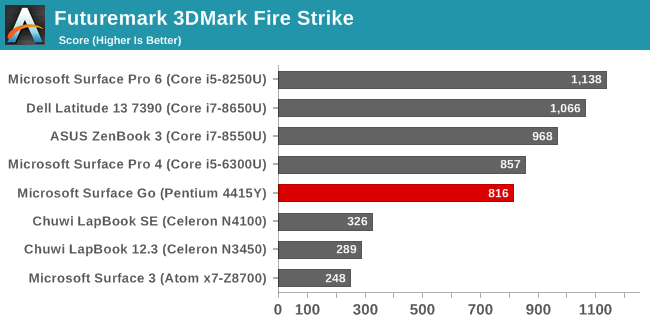
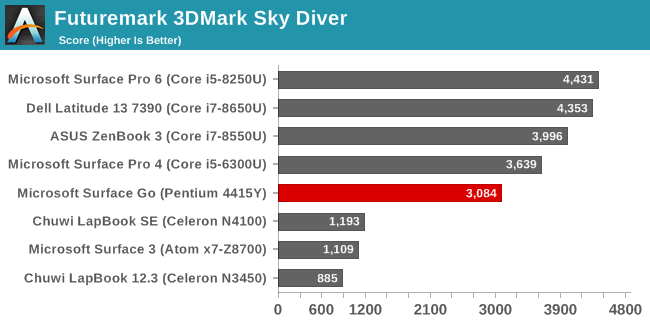

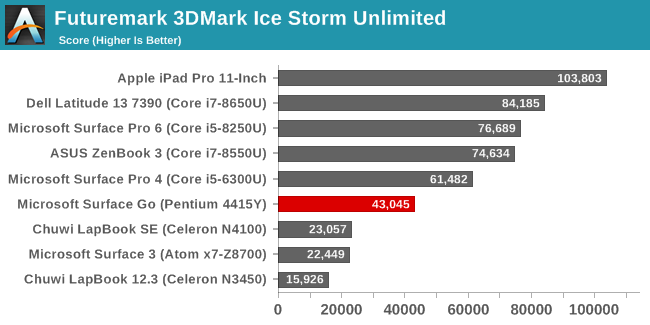
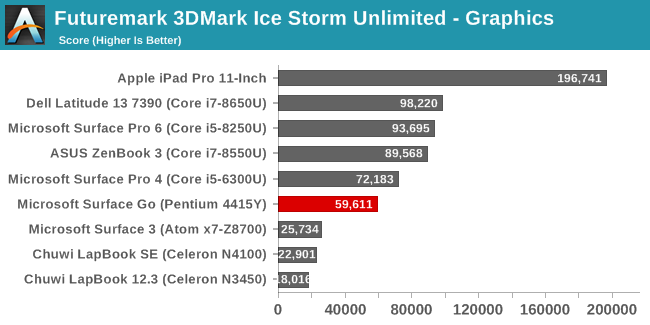
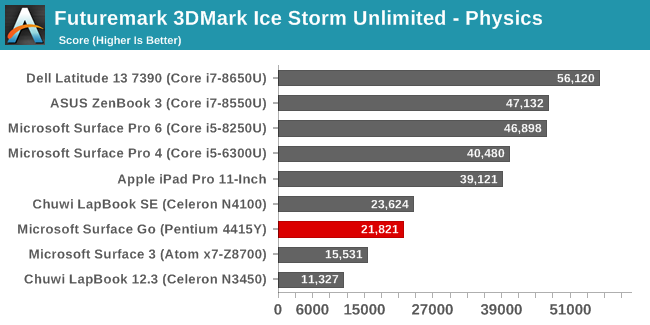
3DMark offers several tests with varying levels of scene complexity, with Fire Strike as the most complex one we run on laptops, followed by Sky Diver, Cloud Gate, and then finally Ice Storm Unlimited which is a test that can also be run on smartphones and tablets.
What’s most interesting is in Fire Strike, if you compare the Kaby Lake based Surface Go with the Skylake based Surface Pro 4, the results are actually quite close. With such a complex scene, the GPU is really the limiting factor more than the CPU, and with both featuring a similar GPU with 24 EUs, the results are really similar, but once the scenes get less complex, the CPU is a larger portion of the task, and the performance drops off fairly dramatically. Ice Storm Unlimited is broken down into the GPU score and the Physics score, with the Physics score being more or less a CPU task, and as we saw on the previous page, the Core i5-6300U is about twice as fast.
Comparing these results to Atom though shows that even though Gemini Lake offers a processor which can meet or beat the Pentium Gold 4415Y, on the GPU side, the meager 12 EUs on Atom are a severe hinderance.
GFXBench
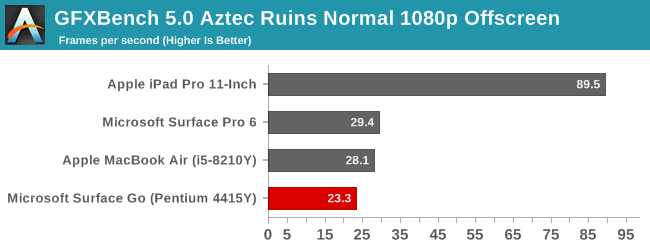
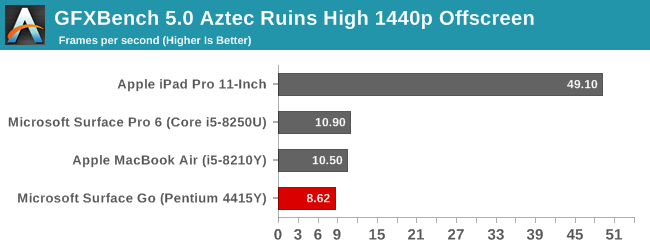
We’re moving over to the latest GFXBench version from Kishonti, which moves away from the OpenGL based tests they offered on Windows, to DirectX 12 with the Aztec Ruins scene. As such, our data is limited, but the results show that the GPU found in the Surface Go is more or less as good as those in higher priced Core offerings, with performance only slightly behind the Surface Pro 6, or even the Y series Apple MacBook Air.
GPU Conclusion
Although the CPU takes a beating when comparing Pentium Gold to Core, the GPU doesn’t suffer the same fate. With the same 24 EUs available as most of the U and Y series Core processors, performance is not hampered quite as much as it is on the CPU side. The overall boost frequency of the GPU is slightly lower compared to a Core i5-6300U, but don’t forget the Pentium Gold 4415Y is also a 6-Watt TDP, so that makes sense. Whereas comparisons on the CPU side with Intel’s latest Atom actually favor the Atom, on the GPU side the Core based Pentium in the Surface Go is much more powerful.
Storage Performance
Microsoft offers two storage offerings in the Surface Go, with the base model being just 64 GB of storage, and the higher tier model features 128 GB. The base model is also eMMC, compared to a true PCIe SSD in the 128 GB model, with the review unit featuring a Toshiba BG3 series. Microsoft moved to a BGA SSD on the Surface Pro in the last couple of models, and the Surface Go also goes with a BGA SSD. That does mean the PCIe interface is just two lanes, which will restrict maximum performance compared to a four-lane model.
The BGA SSD offers good read performance, but write performance with such a small drive takes a big hit. It would be interesting to see this compared to the eMMC version, but we’ve not had a change to test that one. Odds are it would be significantly less performant.


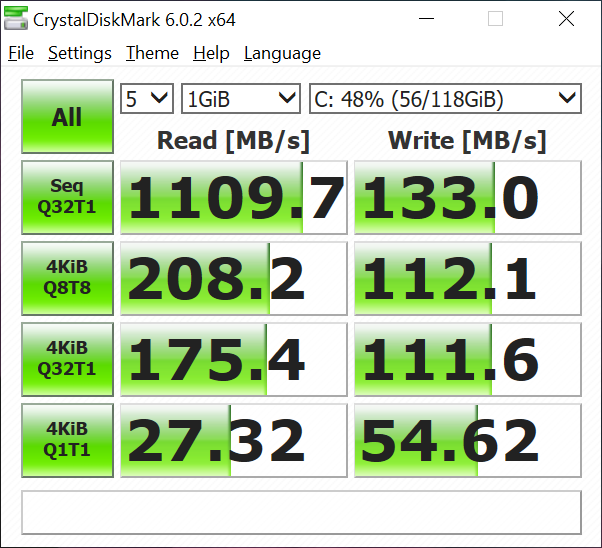








79 Comments
View All Comments
thewishy - Thursday, January 17, 2019 - link
I've had a non-lte 8/128gb since November. I have a work Dell XPS 15, which is hugely powerful but has shockingly bad battery life and is utterly unsuited to use on a plane - so I have another machine to do heavy lifting.This machine gets used on work trips where I don't need much more than an RDP client to a lab, work, excel and OWA, and I want something to entertain me on long flights and evenings if I feel like.
It works brilliantly on the tray table in economy, the battery life might be "Poor", but with a 99wh USB-PD power pack the endurance of 16-24hrs. Given the cost and ease with which the life can be extended, 6hrs of browsing / word and 8-9 hours of movies without the power bank is reasonable IMHO. I wouldn't want to make it heavier for the sake of enhanced endurance. USB-PD charger allows me to charge phone, laptop and power bank with a single charger.
Performance is... slow. It's very noticeably less snappy than anything else I use, but doesn't crawl to a halt under load (For example, no problems with it swapping out). Under light use it's fine, and it works fine for light games.
Screen is sharp, a mouse transforms usability for office use. Keyboard is ok after a short adjustment period, but the trackpad can get in the way occasionally.
Bezel is a little large, but does make it easy to hand hold.
Lack of USB-A is a bit of a pain if you have a Yubikey, and a second USB-C would be lovely if you're using that for charging.
As my only machine it would drive me nuts, but for a specific use case it's been perfect.
TheinsanegamerN - Saturday, January 19, 2019 - link
The interior design of the Go is pathetic for battery packaging. You wouldnt have to make it thicker to fit more battery in there.Trefugl - Thursday, January 17, 2019 - link
Any idea how the CPU performance compares to the original Surface Pro (16:9 one)? I have one of those that I still use for travel, but it's definitely showing its age and the pen input isn't nearly as good as modern surface tablets, and the screens are nearly as nice either... Ideally I'm hoping that I could do some light editing of raw photos in lightroom while on the go, even if it's mildly painful... still better than trying to do it on my phone or carrying around something much bigger.Brett Howse - Thursday, January 17, 2019 - link
Hi Trefugl. I'll reference you to our Online Bench which was also linked in the article:https://www.anandtech.com/bench/product/1207?vs=23...
HStewart - Saturday, January 19, 2019 - link
I also have original Surface Pro and rarely use it - even though it performance is around i7 Y CPU.A good link to compare cpus is the following
https://cpu.userbenchmark.com/Compare/Intel-Pentiu...
It going to be really interesting to see Lakefield - it will like beat the Surface Pro 1 cpu in performance and have extreme battery life - this will be perfect for LTE companion
HStewart - Saturday, January 19, 2019 - link
Computer performance changes over time - I did use my Surface Pro 1 for photoshop and even Lightwave - but new CPU's today make a big difference.eastcoast_pete - Thursday, January 17, 2019 - link
Interesting device, somewhat overpriced. I really wish MS would go further on the mobility aspect and provide a significantly (50% bigger) larger battery. Even with 100 g more weight, it would still be light enough to carry around. Always connected shouldn't mean being plugged into an outlet after just a few hours.tmanini - Thursday, January 17, 2019 - link
"Microsoft also color calibrates all of its displays"I didn't find a handy reference article for this, so I can't confirm the statement or what exactly is done. But even if they do 'something' before it is boxed up, that calibration will drift in short order and essentially become useless. (if you plan to rely on it)
melgross - Thursday, January 17, 2019 - link
That’s not true. It used to be true in the days of the crt, but not now. Apple also calibrates all of its displays, including those in the iMac, and it’s pretty stable. That doesn’t mean that several years later it’s still perfect, but it’s pretty close, even then.The thing about these though, is that they’re just sRGB, which isn’t saying much these days.
anactoraaron - Thursday, January 17, 2019 - link
Exactly this. What exactly is the point of having a calibrated accurate display for maybe 1 month? Panels drift the most in the first year.The other thing that happens not just here at AT is these notebooks and tablets being touted as 'for image and video professionals' just because the display is accurate out of the box. This needs to stop.
Any system that lacks a display osd/hardware rgb channel/brightness/contrast adjustment isn't suited for any professional. Software can only do so much (making adjustments through Intel graphics software is awful) and for folks that absolutely need color accuracy (longer than 1 month out of the box) need the ability to adjust color channels, brightness, and contrast at the hardware level. I had a surface pro, and over time software couldn't properly calibrate it anymore. Sold it recently and went back to desktop, mobility be damned.